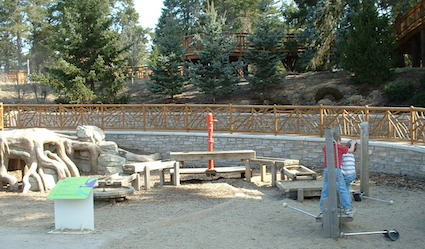Being able to visit a range of playgrounds and outdoor spaces has been one of the side benefits of working worldwide. It has also reminded me of a long overdue need to blog about the Children’s Garden at the Morton Aboretum just outside Chicago. The description on the website is apt:
“At The Morton Arboretum, imagination lives, curiosity grows, and kids flourish in the Children’s Garden. Splash through secret streams, climb colossal acorns, and slide down giant tree roots all day long. Explore, learn, and play among trees and the natural world. The Children’s Garden incorporates ten themed gardens, each with engaging and interactive activities that children will find irresistible.“

These photos were taken back in 2008 whilst on my Churchill Travelling Fellowship. I think they are good to demonstrate that creative playgrounds have always been around and it’s not a new or trendy thing.

In 2008, I had just finished reading Last Child in the Woods by Richard Louv. It is a highly readable and thought-provoking book which captures the concerns of many about what is happening to childhood. When I visited the US, there were lots of people and organisations who felt strongly about this issue and taking positive action. This play park had recently opened and was very different to anything I’d previously encountered. The playground was much more creative than many affairs. Children of all ages were playing there. There seemed to be something for everyone.

I believe the original idea was to provide a place where children could free play and adults would feel able to let them get on and do this. Another aim was to get the children and families interested in visiting the Aboretum and exploring further. In this respect, the playground has been too successful. The children don’t get bored and want to stay at the playground all the time!

What impressed me was the diversity of experiences in a relatively small and compact area. The overall theme was that of plants. This can be seen in the design of the light exploration area featured at the top of this post. Upon closer inspection, the leaf panes were grubby with finger prints and nose rubbings of children pressing these parts again the panes.

The idea behind the large ring is to provide silhouettes that move during the course of the day and to provide interest for babies as well as older children. Close by – which you will see in other photos, are mirrored balls which also enabled more light explorations. These are all in the Curiosity Garden.

The interconnecting streams and water areas were hugely popular, especially with the older children. Some streams were dry. Others were semi-dry depending on the time of year and availability of water. The stepping stones in one half of the pond provided a high affordance area. Nearby, creatures lived in a pond that was for nature watching.

The areas all offered some interesting invitations to explore. For instance, there were stones leading off the board walks and into the water play area.

If you look at the sand area you, can see it overlaps with the underground cave encouraging children to move from one area into another and make links in their play.

Everywhere, there were plenty of informal seating places. I rather liked this as parents could either join in the fun or sit back and enjoy watching their children explore. Much of the space works quietly for children who are less mobile. For example, going under the root trees below is doable.

At the top of the hill was a huge tree house platform. There were various ways of reaching it. The netted walkway was one option. When the feature opened, staff wanted the children to enter from either side so that they would have to negotiate with oncoming children and there by facilitate interactions.

Part of the walkway is also wheelchair accessible. I always feel this is a key indicator of a decent play area when inclusive features blend naturally into the space without it being obvious.

Looking online, it would appear that the Morton Aboretum Children’s Garden is thriving, withstanding a lot of love and providing hours of free play for visiting children. Any further information about the place is is gratefully received.This playspace was designed by Herb Schaal who specialised in botanic garden play designs but the garden appears to have undergone further design upgrades since 2008. Another interesting aspect is that some of the elements of this playground are from the playground company Richter-Spielgerate.
This blog post was first published in April 2015.



















